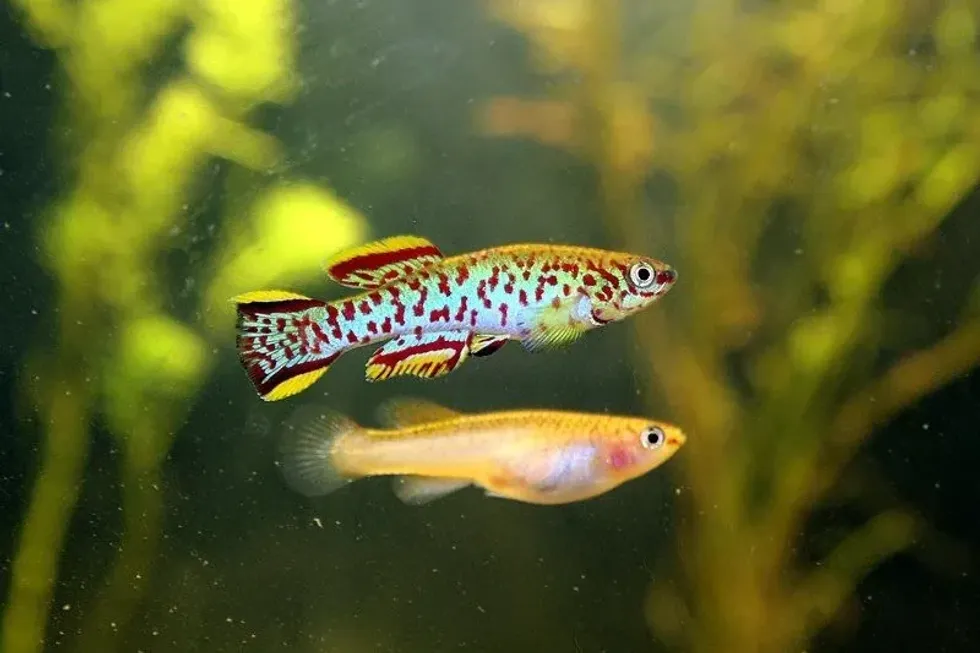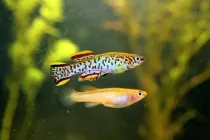Do you want to start your aquarium with a small fish? If yes, you may want to check out the steel blue lyretail, one of the most commonly found killifish variants widely purchased for aquariums.
The scientific name of this fish is Fundulopanchax gardneri, and so it is also known as the gardener's killi. This small and beautiful fish species has done an amazing job in moving worldwide from Nigeria and Cameroon. Moreover, as this isn't an annual variant, the fish manage to live for around three years.
If you love to see fish babies, then you are in for a treat with this killifish. The steel blue lyretail killi has made many people fall in love with the art of aquarium making, and taking care of it is very easy.
So, rather than getting an expensive clownfish, think about bringing home a sturdy killifish that's suitable for most aquariums and water hardness.
Find this fish interesting? Keep reading to learn more blue lyretail facts. Also, check out some more fun and informative articles about suckerfish facts and milkfish facts.
Blue Lyretail Interesting Facts
What type of animal is a blue lyretail?
The blue lyretail (Fundulopanchax gardneri) is a type of tiny fish that is also known as gardner's killi.
What class of animal does a blue lyretail belong to?
The blue lyretail belongs to the class Actinopterygii and to the genus Fundulopanchax. Even sharks belong to the same genus as this killifish. The scientific name Fundulopanchax gardneri is used for this species.
How many blue lyretails are there in the world?
As this killifish has made its way to different parts of the world, it has become impossible to study the exact population of this species. Moreover, there are times when killifish breeders themselves are confused about the species and may end up selling guppies instead of lyretails.
Where does a blue lyretail live?
Steel blue lyretails are endemic to Cameroon and Nigeria. These beautiful fishes reside in swamps and marshes created in the Benue and the Cross River basins. However, due to the extensive pet trade, the killifish has also made it into the hobby display of many aquarists.
What is a blue lyretail's habitat?
By the description of the native places of this killifish species, you can understand that it hails from a warmer place. The steel blue lyretail is able to survive in forests as well as in marshes.
However, for most of us, the blue lyretail's habitat will be a fish tank. Hence, it needs to be favorable with the correct temperature and lighting for the killifish to thrive.
With this killifish having an affinity to jump, it's better to get a tank with an adequate cover. You may also invest in some floating plants to create a natural layer on the top.
Who does blue lyretail live with?
We don't really know a lot of info about the living conditions of blue lyretails in the wild. However, this killifish species is quite good at living peacefully with other fish when kept in a community tank.
Try to avoid adding too many males into one tank as it may lead to aggressive behavior between males. Other than that, this fish species will work well with any aquarium when the light and water conditions are correct to allow the fishes to have a proper lifespan.
How long does a blue lyretail live?
Even though most killifish tend to have a short lifespan of just a year, there is an exception for this fish. With proper care of the aquarium, your blue lyretails can manage to live for up to three years.
How do they reproduce?
One of the most interesting things about killifish is their spawning techniques. It is known as the semi-annual or switch method where the eggs are prevented from getting wet even when it is fully submerged underwater.
So, the egg laid by the females during the spawning usually sinks down to the bottom. When the temperature and water conditions are optimal and right, it takes around 14–21 days for the eggs to hatch. A female may lay around 30 eggs during the spawning season.
If you plan on breeding the steel blue killifish, you will need to act very fast. Choose a tank with ample space and add a male fish along with four or five females.
Make sure to line the bottom with peat or a similar substrate that would catch every egg. After the spawning gets over, the female fish will come down to the peat substrate to bury the eggs.
This is time for you to take away the egg-laden peat to give each fry a new life. The new fry of a few weeks likes to feed on fresh or frozen brine shrimp.
In the wild, the dark substrate of the ponds or rivers works as the place to hide the eggs after breeding for the female, just like we use peat in aquariums. Then, after the eggs hatch, the fry comes free from the natural substrate or peat to feed and swim in the water.
What is their conservation status?
The International Union for Conservation of Nature (IUCN) Red List classifies the steel blue lyretail (Fundulopanchax gardneri) in the category of Least Concern. Yet, the organization also shows a decreasing population trend for this killifish species, which might be due to the decrease of its strength in the natural habitat of Africa.
Blue Lyretail Fun Facts
What does blue lyretail look like?

When it comes to describing the physical appearance of the steel blue lyretail (Fundulopanchax gardneri), it is simply beautiful. These small fishes have a blue and yellow body that looks elongated.
All over the body, you will find red or brown spots. Moreover, the tail ends with a splash of yellow, making this fish even more beautiful.
This fish also happens to have big fins, which allow it to swim around an aquarium with ease. These fins of the male fish almost have stripes of different colors.
Also, the slightly extended tail fins make the body look slightly longer than its original size. Leaving aside everything, you will mostly remember the steel blue killifish because of its brilliant shining scales that never fail to catch your eyes.
How cute are they?
The blue lyretail fish is extremely cute, especially when it is just a few weeks old. These fish look exquisite when they peep out from their hiding places and plants present in the aquarium.
How do they communicate?
When kept in a big enough tank, they are able to communicate with each other easily. You can even add floating plants to the tank to give some privacy to each killifish.
How big is a blue lyretail?
The average size of the steel blue lyretail is around 2.6 in (6.5 cm). Seldom do both the male and female lyretails grow bigger, and it makes them the perfect-sized fishes to be kept in small aquariums. Compared to it, the guppy grows to a size of 0.6- 2.4 in (0.2-0.9 cm).
How fast can a blue lyretail swim?
Even though this is a commonly found fish that has been found in several households, we don't really know the swimming speed of lyretails.
How much does a blue lyretail weigh?
We don't really know about the exact weight of the lyretail (Fundulopanchax gardneri). However, we can guess that it won't be much because of its small size.
What are the male and female names of the species?
There are no separate names for the male and females of this fish. This species has sexual dimorphism, so the females and males look quite distinct from each other.
While the males tend to be brighter with hints of yellow on the fins, the females lack those bright colors. Instead, the females have brown spots all over its body rather than the red found in the male.
What would you call a baby blue lyretail?
When fish babies hatch from an egg, the larvae are known as fry.
What do they eat?
The blue lyretail (Fundulopanchax gardneri) is a shy eater, so you may need to present it with brine shrimp or keep an eye on it to make sure it is eating. But, other than that, this is one of the most easy-to-maintain fish species that you can get.
It likes to feed on mosquito larvae and cyclops, but it will also happily consume commercial fish food.
If you have bigger fish in the same aquarium, make sure that the killifish is getting a wholesome diet. Sometimes live food also works as a great treat for this breed.
Are they dangerous?
No, the steel-blue lyretail (Fundulopanchax gardneri) is thought to be a docile and peaceful fish that can easily adjust with community tanks. Moreover, this fish is too small to harm any human and can easily be handled while changing tanks.
The only concern is about the males being aggressive to each other. Hence, you should think about setting up a different tank if you care about breeding pairs. Also, this killifish species is not known for nipping the fins of others.
Would they make a good pet?
Yes, the steel-blue lyretail (Fundulopanchax gardneri) is a common fish found in the pet markets. Its ability to fit into different community tanks makes it a favorite of many fish enthusiasts.
Moreover, because of its shimmering scales, the fish is even more popular among children and aquarists. Taking care of the breed is also relatively easy, and no special care needs to be taken.
People have also been successful in breeding these fishes right in their aquariums. Feeding the fish is also eat as it isn't fussy about its foods and can eat everything from commercial fit pellets to brine shrimp. However, you need to make sure that the diet is rich in nutrients so that the fish can maintain its beautiful color.
Another reason for this fish being a good pet is because of its low price. This has made the fish popular in areas like Asia and the rest of Africa, where people are genuinely enthusiastic about maintaining aquariums.
Did you know...
The blue lyretail, Fundulopanchax gardneri, prefers to live in slightly acidic water with a pH level of 6.0-7.2. Also, the preferred temperature range is around 72-77°F (22.2-25°C). If you want the male of this species to have the best color, make sure to maintain a dim to medium level of light in the aquarium.
Both males and females of this fish breed tend to jump, so make sure to utilize enough plants on the surface of the water. Moreover, plants also help to deflect extra light that might make the fish uncomfortable. We found Java moss and Singapore moss to be the best plants for such aquariums.
Are lyretail anthias hardy?
Yes, the lyretail anthias variant is quite hardy, and it can easily mix with the aquarium environment. This makes it a popular choice for people who want to keep aquariums.
Are killifish aggressive?
Not really, most killifish species, like the blue lyretail (Fundulopanchax gardneri), are known for being peaceful and can easily mix with the aquarium environment. However, if male fishes are introduced too soon, then there might be an unnecessary fight. Hence, if you are a beginner, it would be best to set up a specific tank to keep the killifish.
Here at Kidadl, we have carefully created lots of interesting family-friendly animal facts for everyone to discover! For more relatable content, check out these longhorn cowfish facts and pumpkinseed sunfish facts for kids.
You can even occupy yourself at home by coloring in one of our free printable intricate fish coloring pages.









